Webmaster’s blog 2019
Alan Wood’s microscopical diary
November 2019
At the committee meeting last month, it was agreed that the Club should have an Instagram account to attract young people. I went to the Instagram website in a browser on my Windows 10 computer and set up an account for the Club, but then found that there was no way to upload photographs. The Instagram website was no help, only providing links to apps for iOS and Android, but Google found a reference to the official Instagram app for Windows available in the Windows Store. I installed it, but found it to be incredibly slow and I only managed to upload one photo. Back to Google, and I found that the Vivaldi browser can pretend to be a Samsung phone and this makes it possible to upload photos from Windows 10.
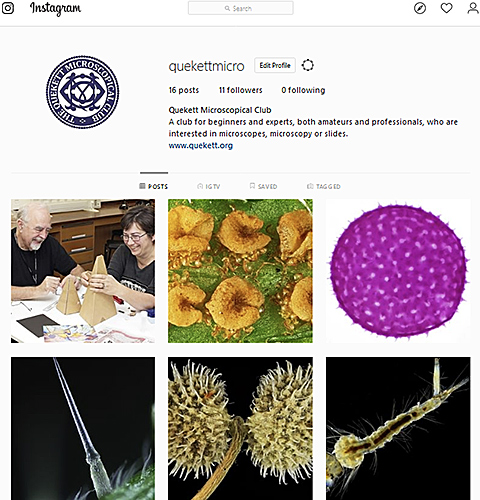 quekettmicro page on Instagram
quekettmicro page on Instagram
Most of the photographs are really rectangular, but to see the whole images (and the captions) you need to click one of the square images. You can see the Club’s page here:
So far, it only has some of my best photomicrographs and macro shots, and a few photos from recent events.
October 2019
Lots of meetings this month but I have run out of ideas for new things to show. For the Annual Exhibition on 5th October, I demonstrated how easy it is to take photomicrographs with a digital SLR camera tethered to a computer, using my Canon EOS 5D Mark II controlled by EOS Utility software.
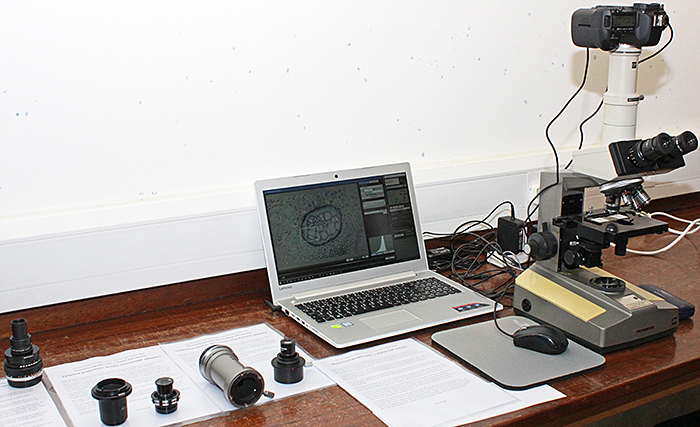 Exhibit at Quekex
Exhibit at Quekex
For the AES Exhibition on 12th October, I used Dennis Fullwood’s Olympus SZ4045 stereomicroscope to demonstrate a simple system for shadowless illumination using an LED ring-light shining up into an inverted kitchen bowl with its base removed. This setup provides clear images of insects and also worked very well with an insect in amber.
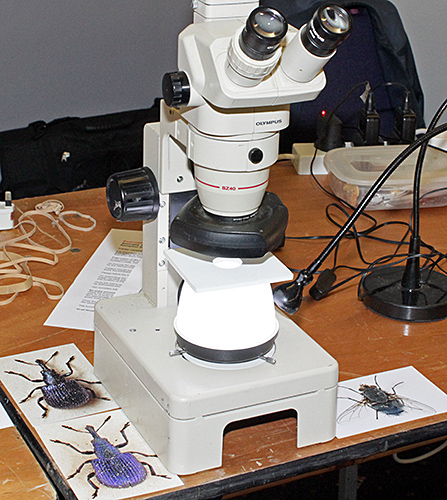 Exhibit at AES Exhibition: shadowless illuminator with a stereomicroscope
Exhibit at AES Exhibition: shadowless illuminator with a stereomicroscope
I want to find a good way to take photomicrographs at club meetings, but I do not want to have to carry my own microscope and laptop computer, so I have been looking at camera adapters that clamp onto a standard 25 mm (external diameter) eyepiece tube and at afocal arrangements. From what I have read of other people’s experience with clamp-on adapters, I thought I needed a low-magnification eyepiece to get a wide field of view. I had a few low-power ones and several others, and I tested them all with a 20× objective and 1 mm stage micrometer.
| Eyepiece | Field of view |
|---|---|
| Olympus P 15× | 0.63 mm |
| Olympus P 10× pointer | 0.66 mm |
| Olympus NFK 5× | 0.67 mm |
| Olympus P 10× | 0.68 mm |
| Reichert 5× Plan | 0.74 mm |
| Olympus NFK 3.3× | 0.87 mm |
| Lomo P 7× | 0.88 mm |
| Olympus FK 3.3× | 0.88 mm |
| Reichert 6× | 0.89 mm |
| Lomo P 7× photo eyepiece | 0.93 mm |
| Olympus P 7× (ridged top) | 0.97 mm |
| Olympus WHK 10× | 0.98 mm |
| Olympus P 7× (flat top) | 0.99 mm |
| Olympus FK 2.5× | > 1 mm |
| Olympus NFK 2.5× | > 1 mm |
I showed a simple camera adapter as part of my exhibit at the Annual Exhibition of Microscopy.
 Left to right: Lower part of adapter, microscope eyepiece, upper part of adapter, T2 adapter for camera
Left to right: Lower part of adapter, microscope eyepiece, upper part of adapter, T2 adapter for camera
I also showed an afocal arrangement with a Periplan 519750 10×/18 eyepiece and an Olympus Zuiko 50 mm f/1.8 standard lens. My first tests had vignetting on full-frame, so I need to experiment further.
 Left to right: Leitz Periplan eyepiece with male 28 mm thread, step-down adapter from camera filter size to 28 mm, standard lens from a 35 mm SLR camera, adapter for using Olympus OM lenses on Canon EOS SLR bodies
Left to right: Leitz Periplan eyepiece with male 28 mm thread, step-down adapter from camera filter size to 28 mm, standard lens from a 35 mm SLR camera, adapter for using Olympus OM lenses on Canon EOS SLR bodies
September 2019
We finally sold the flat at the end of August, so now I am trying to catch up with the backlog of meeting reports. For the report of the “Rocks and minerals” gossip, I wanted to show the effect of crossed polarisers and a retarder, so I prepared 3 photographs of the same part of a thin section of sillimanite:
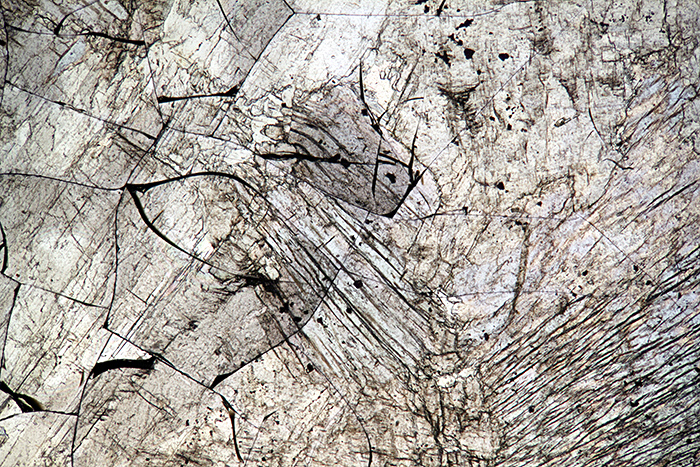 Thin section of sillimanite by transmitted light
Thin section of sillimanite by transmitted light
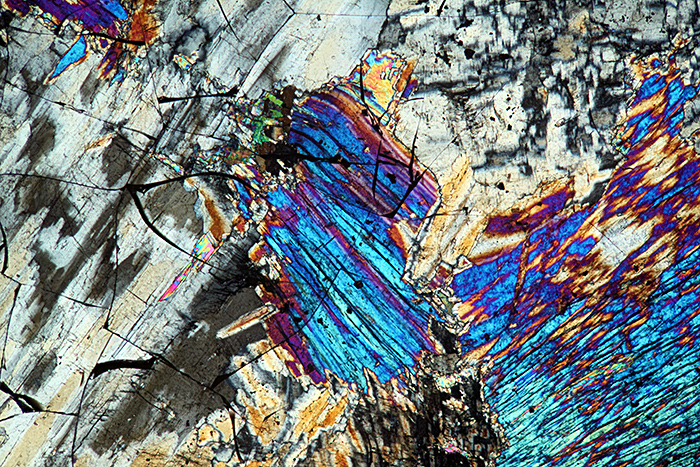 Thin section of sillimanite with crossed polarisers
Thin section of sillimanite with crossed polarisers
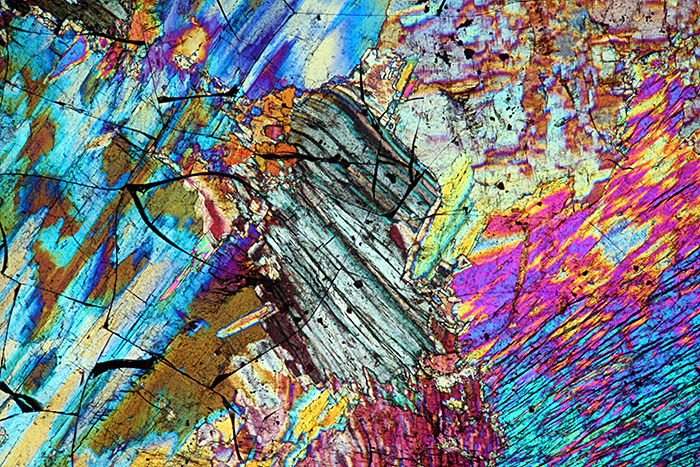 Thin section of sillimanite with crossed polarisers and a retarder
Thin section of sillimanite with crossed polarisers and a retarder
I used my Olympus BHT with 4× SPlan objective and 2.5× NFK photo eyepiece, with the B-AN analyser that fits in the recess under the head and the A-PO polariser that sits on the filter holder. The images are not cropped, they show the whole field of view through my full-frame Canon EOS 5D Mark II. The retarder was from the window of a cake box. Rotating the slide or the retarder changes the colours.
August 2019
Still busy with all the paperwork of selling our flat, but I sorted out some thin rock sections for the “Rocks and minerals” gossip on 23rd August. I got out my NBS Polarspex to see which slides looked good between crossed polarisers, but none of them showed any colours. Then I realised that the lower polariser was missing. Fortunately, it was still in the box, and it was easy to stick back with a drop of PVA glue in each corner.
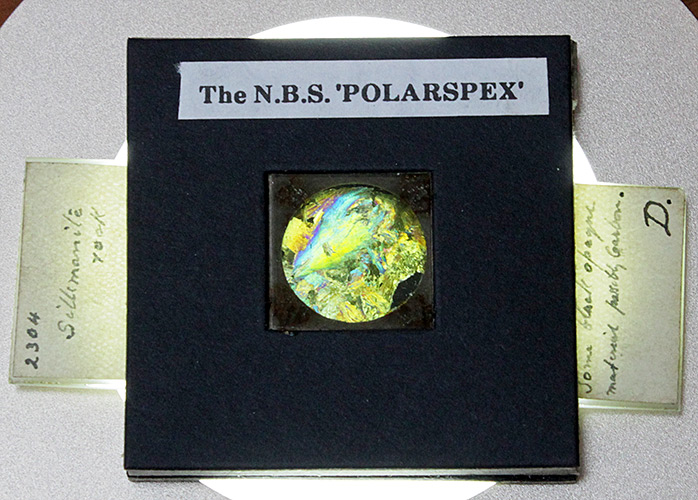 The N.B.S. ‘POLARSPEX’
The N.B.S. ‘POLARSPEX’
I didn’t think my rock sections were anything special, they are not signed and I bought them cheaply on eBay or at Club meetings, so I was surprised when Pam Hamer told me that 4 of them were by C. H. Caffyn.
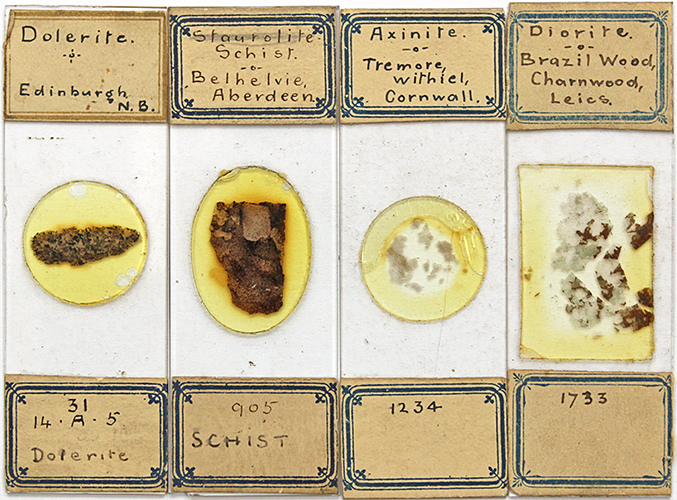 Thin rock sections by Charles Henry Caffyn
Thin rock sections by Charles Henry Caffyn
June 2019
My parents often used to take my sister and me to Wimbledon Common on the 93 bus from North Cheam, and I just about remember carrying my jam jar and fishing net and coming home with small fish or tadpoles from Rushmere. That was 60 years ago, and it is great to be going there again with the Quekett for the excursion, BioBlitz and Open Day. For the BioBlitz on 22nd and 23rd June this year, the weather had only just started to get warm and there were nowhere near as many butterflies and damselflies as last year. I used my Canon EOS 40D with the Canon 60 mm f/2.8 macro lens and Yongnuo YN-14EX Macro Ring Lite and got a reasonable success rate for images to go on the website.
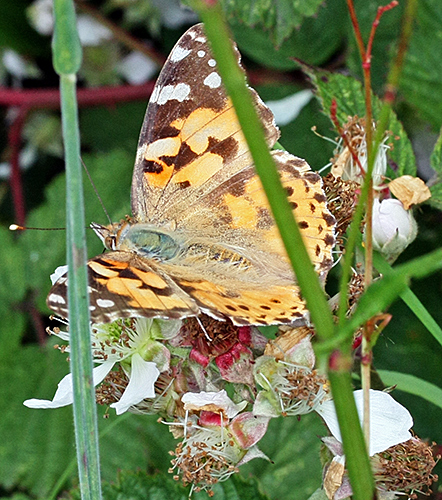 Painted lady butterfly
Painted lady butterfly
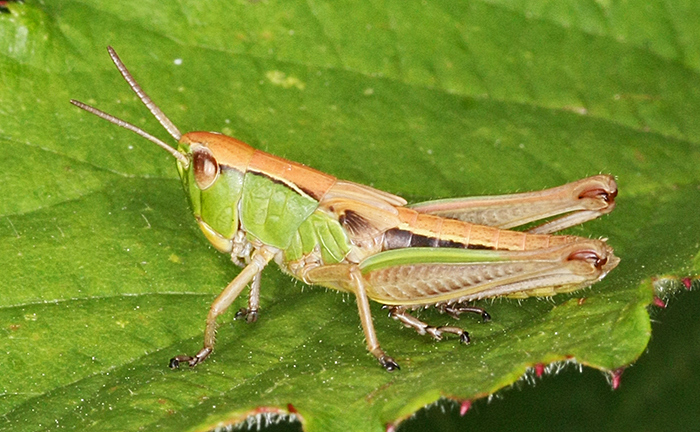 Grasshopper
Grasshopper
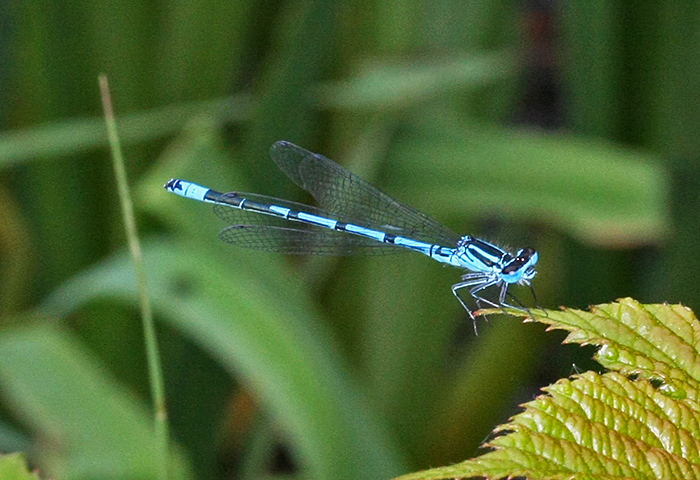 Damsel fly
Damsel fly
I am reminded of being in my late teens and early twenties with a Miranda GT, 40 mm f/2.8 Makro-Kilar lens and a Sunpak ringflash powered by a pack of batteries slung from my shoulder. Now I would not like to be without auto-focus, automatic stop-down and automatic TTL exposure.
A day out on Box Hill on 26th June was completely different, swarming with marbled whites and meadow browns, and we saw several painted ladies and silver-washed fritillaries, but far fewer orchids than last year. We also saw a hummingbird hawk-moth, a first for me, an amazing sight with its wings just a blur.
We moved nearly 2 months ago, but it has taken us a long time to get settled. I have only just started using my microscopes again, because I wanted a photomicrograph to use in promoting the “Arranged specimen slides” gossip on Facebook. The only arranged slide I have is by Brian Darnton, one of the ones that I bought from him at Langton Matravers in April.
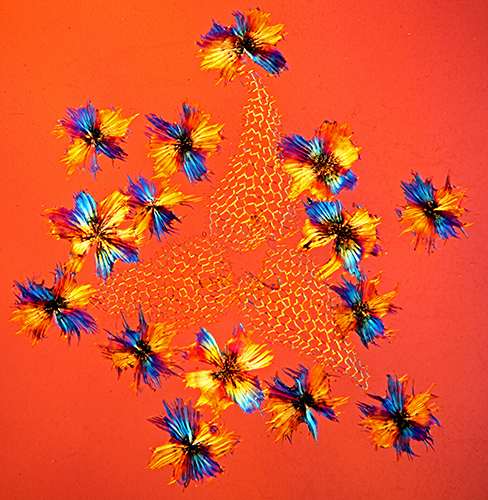 Stellate Art Work by Brian Darnton
Stellate Art Work by Brian Darnton
The arrangement is about 3 mm wide, so to get it all in I used a Carl Zeiss Plan 2.5/0,08 objective and an Olympus NFK 2.5× LD photo eyepiece. The plant hairs and fern scales are colourless, and I used crossed polarisers and a retarder cut from the window on a cake box to produce the colours in the photomicrograph.
May 2019
Moving has provided an opportunity to organise my 5 microscopes and lots of accessories accumulated over the last 15 years, and now almost everything is in a couple of cupboards right next to my desk.
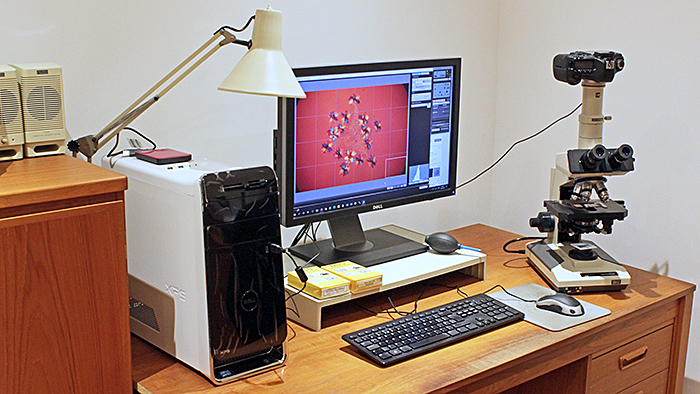 Trinocular Olympus BHT with Canon EOS 5D Mark II controlled from EOS Utility on my desktop computer
Trinocular Olympus BHT with Canon EOS 5D Mark II controlled from EOS Utility on my desktop computer
In the interests of domestic harmony, I have to put my microscopes away when I am not using them. In the flat, I had to lift my BH-2 from floor level and carry it to another room to use it; in the bungalow it is stored at the right height and I only have to move it from the cupboard to the adjacent desk.
At the PMS Husbands Bosworth meeting on 11th May there was a USB cable for a Nikon camera on Mike Smith’s “free to a good home” table so I thought I would try it with my uncooperative Canon cameras. I tried it when I got home, and suddenly my EOS 40D and 600D were recognised by my computer again. Looking closely, it appeared that the plug on the Nikon cable went further into the socket on the side of the cameras than the Canon plug. It turned out that I was not using enough force to push in the Canon cable, and so it did not connect properly. A bit more force and the Canon cable went all the way in and worked!
April 2019
Very little time for microscopy because we are busy moving from a flat to a bungalow, but I still get to as many meetings as I can. A new member who lives near Langton Matravers asked for help with photomicrography and with using crossed polarisers, so I took my trinocular Olympus CH-2, a laptop with EOS Utility, my EOS 40D body and some filters to the meeting on 13th April. I have used this equipment lots of times, but on this occasion the computer would not recognise the camera. I tried the 40D and the 600D and 2 different USB cables, but with no success. Back home I tried them again, on my laptop and on my desktop computer, and they still wouldn’t connect. My EOS 5D Mark II worked fine. I spent hours on the Internet trying to find a solution, but nothing worked.
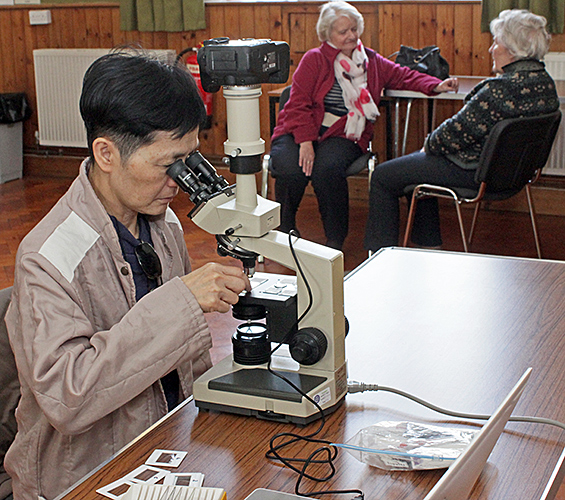 Kai with our trinocular Olympus CHS
Kai with our trinocular Olympus CHS
Brian Darnton was selling slides that he has made, some of forams and some of arranged plant hairs and fern scales, so I bought a couple, but I don’t know when I will get a chance to look at them.
March 2019
I submitted my photo of a stinging nettle hair to the Royal Microscopical Society for their 2019 calendar, but it was not accepted. However, the RMS asked if they could use it for the March 2019 front cover of their magazine, infocus.
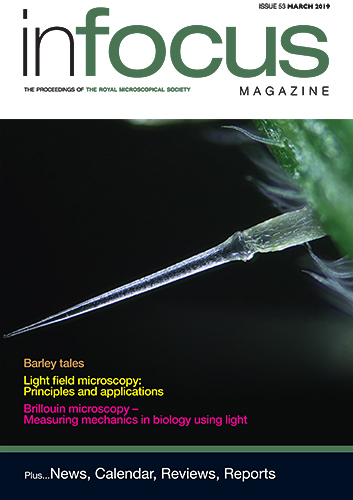 Front cover of infocus March 2019 (issue 53)
Front cover of infocus March 2019 (issue 53)
February 2019
At the workshop on diatoms from Lake Mývatn I followed my normal procedure of taking lots of photographs so that I can pick out the best ones and write the meeting report around them. However, this time the card failed while I was copying the images to my hard disk, and I only managed to recover 3 photos. I don’t try to economise by buying unknown brands, this was a genuine SanDisk Extreme PLUS SD card that I have been using since 2016. SanDisk are going to replace it under guarantee. This card was already a replacement under guarantee, after my previous SanDisk Extreme failed after only a year. Now I understand why some cameras aimed at professionals have 2 card slots, so you have a backup.
January 2019
My first microscope was a Watson Kima, bought second-hand when I was still at grammar school. I have kept it for over 50 years, but now I need the space so I reluctantly decided to give it away. I have used it occasionally over the years and it has always worked fine, but this time the fine focus didn’t work properly – it either did nothing or else moved much too far. I asked for help in the Amateur Microscopy group on Facebook and in the Microscope group on Yahoo! and Merv Hobden and SaraLee Shepherd both replied promptly with the same diagnosis and treatment, and they were correct. The fine focus knobs move a block up and down in a dovetail slider, and the grease had hardened.
With the body tube removed, it should be possible to lift the block a little and it should slide down again. I could lift it, but it didn’t slide down. Following advice, I undid two screws holding the plate on top of the block, being careful not to lose the spring below it. Then I slide the block up and out of the dovetails. I used Ronsonol lighter fluid to clean off the old grease and then applied a thin smear of Vaseline. Everything went back together easily, and the fine focus now works again.
I offered the working microscope in the Amateur Microscopy group and the Microscope Wants, Sales And Services group on Facebook, free to anyone who could collect it, and it now has a new home.
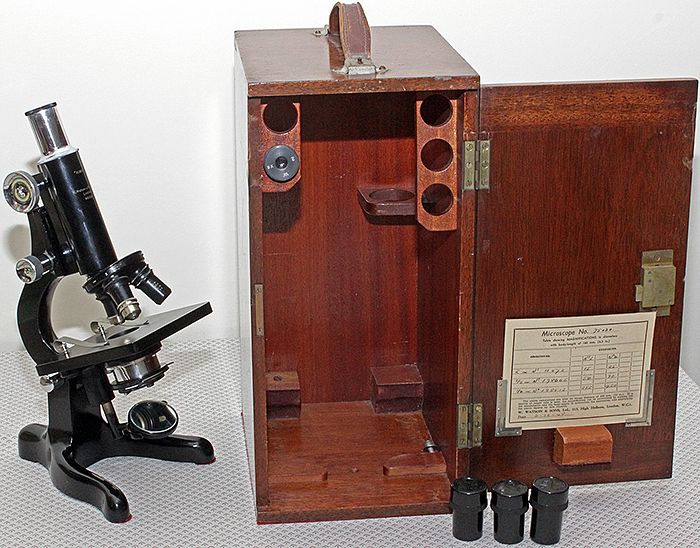 Watson Kima No. 95030
Watson Kima No. 95030
Before parting with it, I added the serial number to the Watson Microscope Stand Dating Table on the Quekett website.
About this blog
I am Alan Wood, former webmaster for the Quekett website, and author of several web pages on Olympus microscopes. I spend too much time writing about microscopes and buying more equipment. I hope this blog will help me to focus on using my microscopes so that I have something to write about!
If you would like to comment on anything in this blog, please contact Alan Wood.

